-
Settings
-
General
- Configuring Shipping Presets
- Update My Profile
- Disable the Inventory Update From Extensiv Order Manager to All Sales Channels
- How to Enable Out of Stock Control for eBay Sales Channels
- Company Info and Additional Account Settings
- Installing an App from the Order Manager App Store
- How to View Your Extensiv Order Manager Invoices
- How To Remove an App in Order Manager
- Ruby Has 3PL Integration
- Company Time Zone Setting
- Tax Identifiers
-
Sales Channels
- Deactivating a Sales Channel
- Editing Sales Channels
- Enable or Disable Extensiv Order Manager Email Notifications to Your Customers
- Shopify Tags
- Shopify Locations
- Amazon Cancellation Settings
- Steps in Adding Walmart as a Sales Channel
- Adding Newegg as a Sales Channel
- Adding eBay as a Sales Channel
- Viewing a Sales Edit Channel's History
- Reactivating Sales Channels
- Adding Amazon as a Sales Channel
- Adding Shopify as a Sales Channel
- Adding a Manual Sales Channel
- Adding Sales Channels
- Assigning a Packing Slip and/or Email Template to your Sales Channel
- How to Exclude a Warehouse From Pushing Inventory to a Sales Channel
- Setting Up Shipment & Carrier Mappings for Your Sales Channels
- Amazon Pacific Time Orderbot Setting
- Walmart Fulfillment Services - WFS
- WFS Workflow
-
Webhooks
- Order Creation Webhook
- Shopify Cancellation Webhook
- Shopify Refund Webhook - POS Orders
- Shopify Fulfillment Webhook
- Shopify Refund Webhook (e-commerce Orders)
- Shopify Product Deletion Webhook
- BigCommerce Webhook
- Shopify Product Update / Product Edit Webhook
- Shopify Auto-Subscribing Webhooks
- Order Payment Webhook
-
Shipping Providers
- Adding FedEx as a Shipping Provider
- How to Add Express 1 as a Shipping Provider
- Adding Amazon Buy Shipping as a Shipping Provider
- UPS Mail Innovations Services
- Adding DHL eCommerce as a Shipping Provider
- FedEx ETD
- Deactivate or Reactivate a Shipping Provider
- Adding Shipping Providers
- Customizing Shipping Services and Package Types Per Shipping Provider
- Vendors
-
Warehouses & Vendors
- Creating and Configuring Warehouses in Extensiv Order Manager
- Can I have additional order information populated on my Shipping label?
- Configuring Shipping Label Print Format Options
- Inventory Dependent Warehouses
- How to Configure the Order Export File for FTP Connections
- Deactivating a Warehouse in Extensiv Order Management
- Updating the Address/Return Address for Your Warehouse
- Search for Vendors
- Configuring a Dropship Vendor
- Creating an In-House Warehouse
- How do I connect Extensiv Order Manager with Deliver?
- Configuring Dropship Vendor FTP
- FTP Inventory Import for a 3PL
- Setting Up Domestic Backup Warehouses
- Setting Up a Warehouse's International Rank
- Pick List Settings
- Setting Up a 3PL Warehouse
- Setting Up Document Print Settings
- Setting a Dropship Template and Fulfilling Orders with a P.O.
- Use Component Inventory Setting for Bundles and Kits
- Instructional Video - Creating Warehouses & Warehouse Settings
-
Orderbots
- Orderbots - Complete List of Filters & Actions
- Postal Zones in Extensiv Order Manager
- Automating Orders to Fulfill from a Specific Warehouse
- Editing an Orderbot
- Deactivating an Orderbot in Extensiv Order Manager
- Mark Order as Shipped Orderbot
- Replace Address Orderbot
- Creating an Orderbot
- Support for Shopify's Additional Details
- Orderbots filtered by zip code range
- Adding Order Item to Order Orderbot Action
- Commonly Used Orderbots
- Understanding Apply Best Rate vs Cheapest Rate Orderbots
- Orderbot: Set order weight and dimensions based on products
- Orderbot: Using Hold the order for and Mark Order as Shipped
- Templates
-
General
Creating an In-House Warehouse
In-House
- Navigate to the Settings module and click Warehouses on the left-hand navigation. Then click, New Warehouse and select Direct (In-house) Fulfillment.
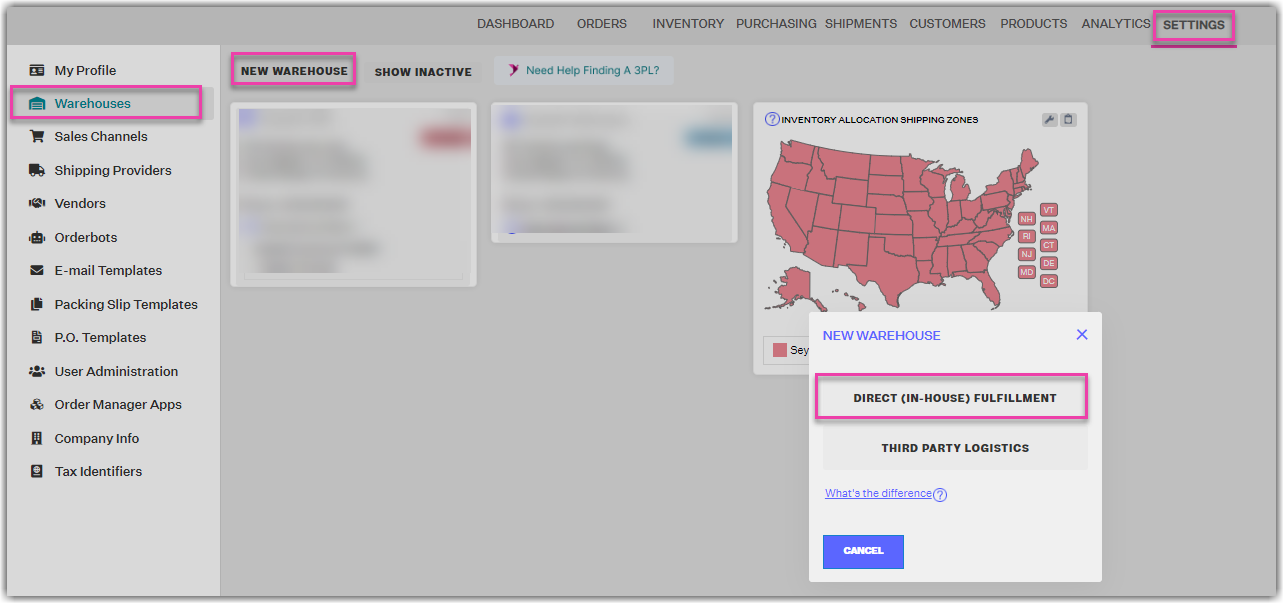
- In the new window, you’ll have to complete several required fields, including:
- Warehouses Name
- Address
- City
- State
- Zip Code
- Country
- Contact Phone
- Once the Basic Info is filled out, you can scroll down to view the Domestic Backup Warehouse section. The checkbox to Add as Backup Warehouse will automatically add this new warehouse you're creating to the Domestic Backup Warehouse list for all of your other warehouses. If you do not want this, then uncheck this box.
You can also select and arrange Domestic Backup Warehouses for this warehouse. Use the dropdown menu to select all of the other warehouses that you want to be backups for this new one. You can rearrange their order once selected by dragging and dropping any row. - Once you’re done, click Continue.

If you create more than one warehouse (in-house) or otherwise, you will be prompted to assign inventory allocation zones. Doing so will assign inbound orders from particular areas to certain warehouses.
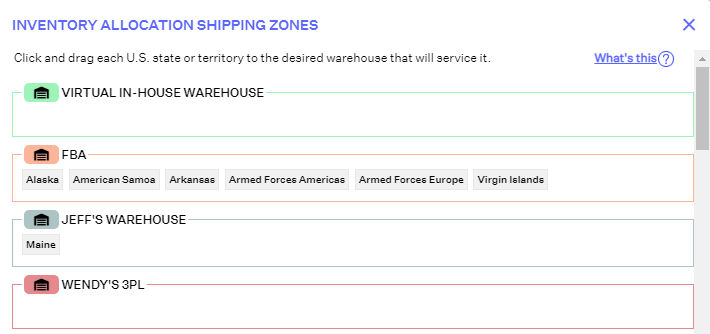
This can also be revised by clicking on the wrench next to the U.S. map on the Warehouses page. Clicking on the clipboard icon will instead show you an edit history of changes made to the allocation zones.
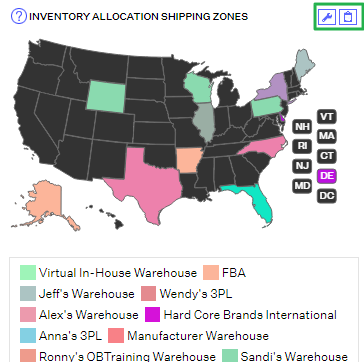
Once you’ve created, the warehouse, you can click the wrench icon next to its name and select from a number of options, including:
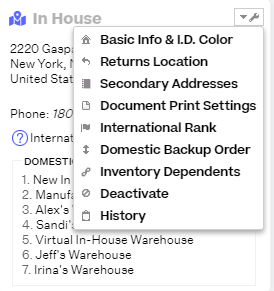
- Basic Info & I.D. Color: you can revise basic warehouse contact information here.
-
Returns Location: this is the location where returned items will go, assuming they were originally fulfilled by this factory. This does not have to match the original address of the warehouse itself.
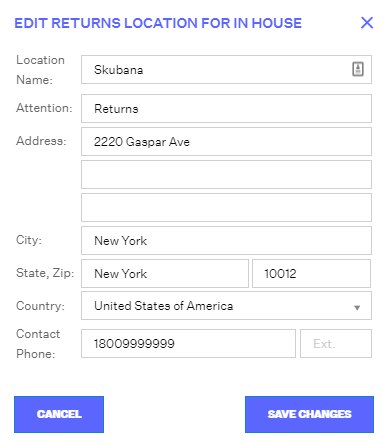
-
Document Print Settings: allow you to customize the orientation and print options for shipping labels, packing slips and pick lists.
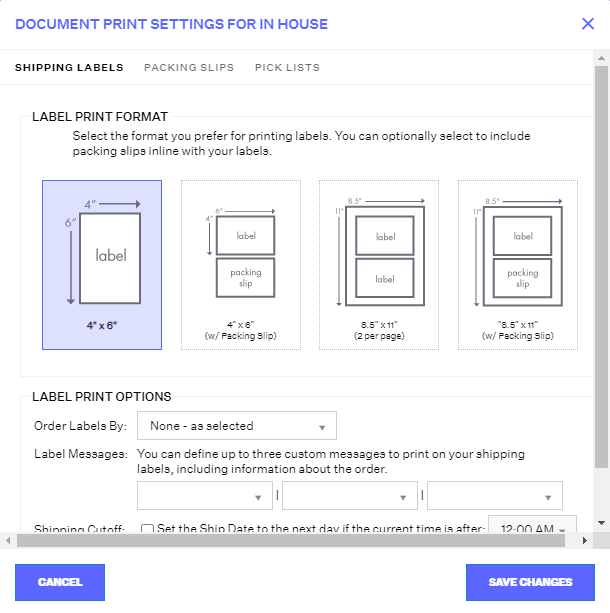
-
International Rank: this is the order in which international orders should be fulfilled, and can be “activated” by creating an orderbot.
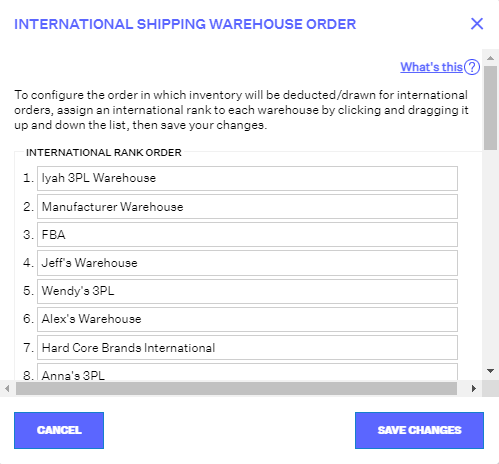
-
Domestic Backup Order: helps you decide the order in which inventory is pulled from if this particular warehouse is out of stoc
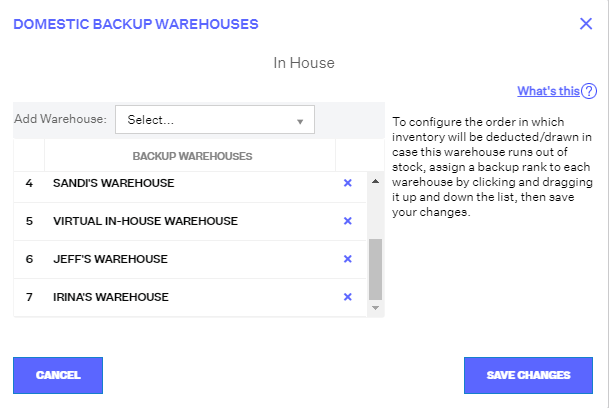
-
Inventory Dependents: these are the warehouses that source new inventory from this Master (Parent) Warehouse.
NOTE: Setting up dependents will result in the merging of sales velocities, which will be reflected in Extensiv Order Manager-generated POs.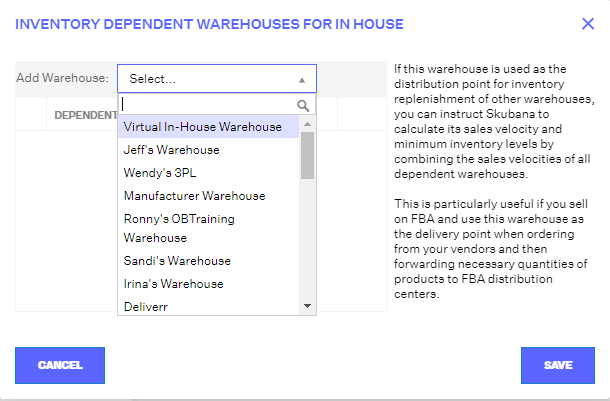
-
Deactivate: this will deactivate the warehouse.
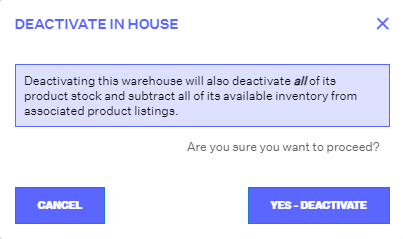
-
History: this tracks the history of actions performed on the warehouse.

 | Help Center
| Help Center
